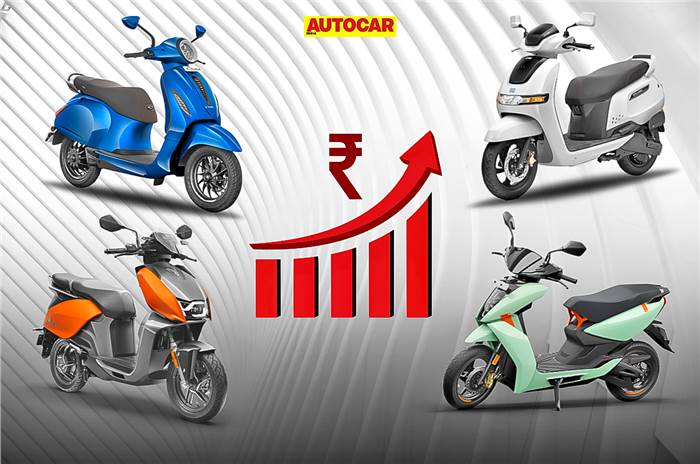The new EMPS (Electric Mobility Promotion Scheme) has come into effect from April 1 and nearly all Indian electric two-wheeler manufacturers have revised the prices of their products. Here’s the detailed break-up of the three largest players.
| Price comparison | |||
|---|---|---|---|
| Old price | New price | Difference | |
| Ather 450S | Rs 1.10 lakh | Rs 1.26 lakh | Rs 16,000 |
| Ather 450X 2.9kWh | Rs 1.38 lakh | Rs 1.41 lakh | Rs 3,000 |
| Ather 450X 3.7kWh | Rs 1.45 lakh | Rs 1.55 lakh | Rs 10,000 |
| Bajaj Chetak Urbane | Rs 1.15 lakh | Rs 1.23 lakh | Rs 8,000 |
| Bajaj Chetak Premium | Rs 1.35 lakh | Rs 1.47 lakh | Rs 12,000 |
| TVS iQube | Rs 1.34 lakh | Rs 1.37 lakh | Rs 3,000 |
| TVS iQube S | Rs 1.40 lakh | Rs 1.46 lakh | Rs 6,000 |
| Vida V1 Plus | Rs 1.15 lakh | Rs 1.20 lakh | Rs 5,000 |
| Vida V1 Pro | Rs 1.46 lakh | Rs 1.50 lakh | Rs 4,000 |
Ather’s sporty 450 range has seen an upward price revision of up to Rs 16,000, and interestingly, it's the most affordable 450S that sees the biggest price hike. The 2.9kWh variant of the 450X sees a small Rs 3,000 bump up in price while the range-topping 450X 3.7kWh sees a Rs 10,000 price hike. The recently launched Rizta is the most affordable model in the startup’s line-up and to read more about that, tap here.
Bajaj’s Chetak line-up has seen a price revision to the tune of up to Rs 12,000. The Urbane costs Rs 8,000 more than it did previously while the Premium costs Rs 12,000 more. The popular TVS iQube line-up has seen a nominal bump up in price, with the base variant costing Rs 3,000 more, while the top-spec S now costs Rs 6,000 more. Hero’s EV subsidiary, Vida, has also updated the prices of both its offerings: the V1 Plus by Rs 5,000 and the V1 Pro by Rs 4,000.
Interestingly, Ola hasn’t hiked the prices of its electric scooters and has extended the current prices till April 15.









Comments
Member Login
Personal Details
No comments yet. Be the first to comment.